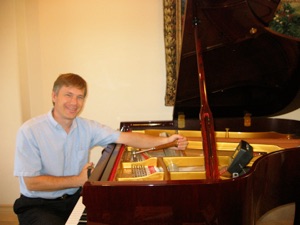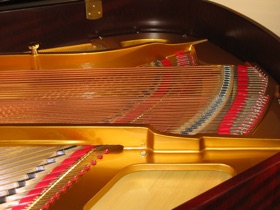Piano Service

Pianos are wonderful instruments that combine more moving parts than a modern automobile to achieve an instrument of musical expression that is second to none. Pianos can express delicate simple melodies and powerful symphonic flights of fancy. The piano has transcended all changes in musical tastes and expression so far. It can be used to relive early medieval melodies and can find a place in the latest avant-garde forms of musical expression we explore today.
Perhaps your piano is not as exciting as the new pianos at the store. Maybe it could be. How long has it been since it has been fully serviced? With tuning, regulation and voicing a piano can seem to come alive again and prove satisfying once more. Most manufacturers recommend that pianos be serviced at least twice a year. Practice pianos are typically serviced quarterly at schools. Teaching pianos are to be serviced monthly. Concert pianos are serviced prior to each concert, sometimes several times a day.
Piano Tuning link
Pianos are made of wooden soundboards and bridges. This wood breaths, hydrates and desiccates with the changing climate around it. These changes in humidity change the internal tension in the soundboard and changes the tension the strings are under as they cross the bridge. String tension and board impedance is what tuning is all about. Like a guitar, a piano can go out of tune quickly with changing weather, but tuning a piano is like tuning forty or so guitars. Unlike guitars pianos have a broad compass with much more inharmonicity that requires tempered tuning techniques to achieve a pleasing temperament that minimizes inharmonicity.
While Mr. Anderson can tune a very well maintained concert grand in as little as forty minutes, most pianos are not that well maintained and require additional time to achieve a fine tuning. Semi-annual maintenance generally takes anywhere from an hour to an hour and a half. Pianos that haven’t been tuned for decades can be well below tension and since the soundboard is flexible, don’t go into tune in one pass. With old strings it is generally safer to make several passes until a fine tuning can be achieved avoiding string breakage. This can take hours. If you need an estimate of tuning costs, ask at the beginning when the pitch is being measured.

and collapse over time with significant loss of tonal power. This can be reclaimed to some extent with structural enhancements. Some soundboards honk at various places in the scale and require the addition of impedance to unify the scale. Sometimes hammers are poorly matched to the scale and soundboard and require chemical additives to increase internal hammer tension to bring the tone to life (in some makes this is a ‘feature’).
Because voicing is so dependent on regulation, major voicing must follow regulation. Minor voicing is done in regular service appointments where it is obviously needed for uneven notes, etc. There will be a comment in the service notes if the voicing needs to be addressed.
Before the service appointment:
Clear everything from off of the top of the piano. Secure the pets in another area of the house. Make sure that the appointment does not occur at the same time as other appointments involving noisy equipment. Figure enough time, two hours to be safe, more if the piano hasn’t been serviced in a long time. Remember that payment is due at the time of service.
Other Services
Installation and service of Piano Disc Ⓡ piano player systems.
Pianos and piano tunings both benefit from climate control installed in or under the piano. Installing a Piano Life-Saver system by Dampp-Chaser® will prove beneficial for your piano. This system automatically controls humidity within the piano silently, maintaining it at a wood-friendly 42% humidity. The Piano Life Saver system will pay for itself many times over during the life of the piano by tunings that sound good much longer and eliminated action repairs that are due to glue-joint failure due to humidity cycling.
To reduce maintenance costs and preserve your grand piano I recommend Dawson string covers. These covers keep dirt and aerosol pollutants out of the piano and off of the piano strings. The predominantly high humidity we face in this climate quickly rusts piano strings. Dawson string-covers will prevent rusting by naturally buffering humidity and preventing condensation on the strings and plate. Additionally Dawson string-covers make a climate control system more effective by closing off the top side of the sound-board and action cavity. The covers can be easily removed but may be left in while you play. If your piano seems sharply bright, the addition of a cover will tame those extremely high partials.

Piano Voicing
Piano voicing can be addressed after the piano is tuned and the action is in proper working order. Piano voicing deals with string-leveling, hammer fit to strings, string-terminations and hammer tension. Sometimes new pianos are sold un-prepped by the dealer and a significant amount of work needs to be done to the regulation and voicing to achieve a pleasing, responsive sound. Piano hammers are made of wool felt which is made
to varying degrees of tension. With use this felt packs and becomes brighter, eventually harsh. Needle voicing can be utilized to adjust the felt tension and bring out the tone the piano is capable of producing.
Sometimes there are other design issues that can affect tone. Soundboards can be structurally deficient (common in some makes)
Piano regulation and repair:
Many of the contact and bearing surfaces in a piano action involve wool-felt and leather. These can compress with use and as a result adjustments may need to be made to the action relationships in order to achieve ideal relationships and touch. Actions are made of wood and can also experience dimensional changes with climate change requiring

adjustments to ameliorate sticking keys or action parts. Your piano’s tone and touch are controlled to a large degree through regulation. Sometimes individual parts will break or bend under use and will require repair or replacement. Eventually felt bearing surfaces do wear out and require replacement. Major regulation issues that interfere with tuning are addressed in a separate service appointment. Mr. Anderson will comment in the service notes if further regulation would be beneficial.